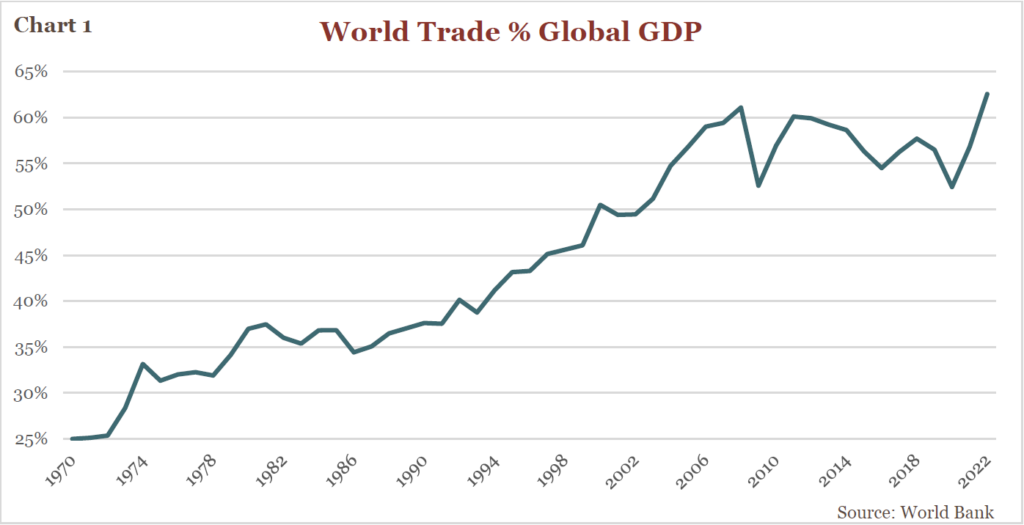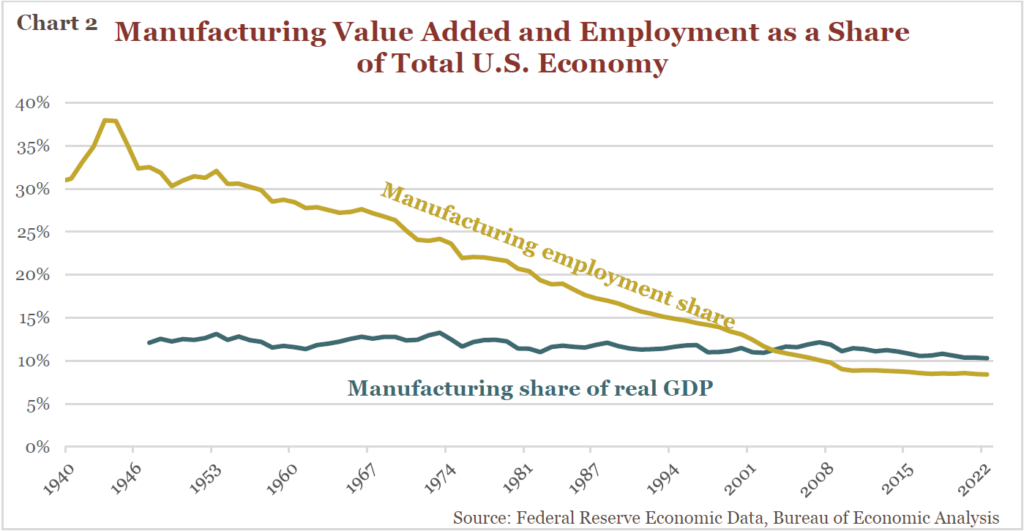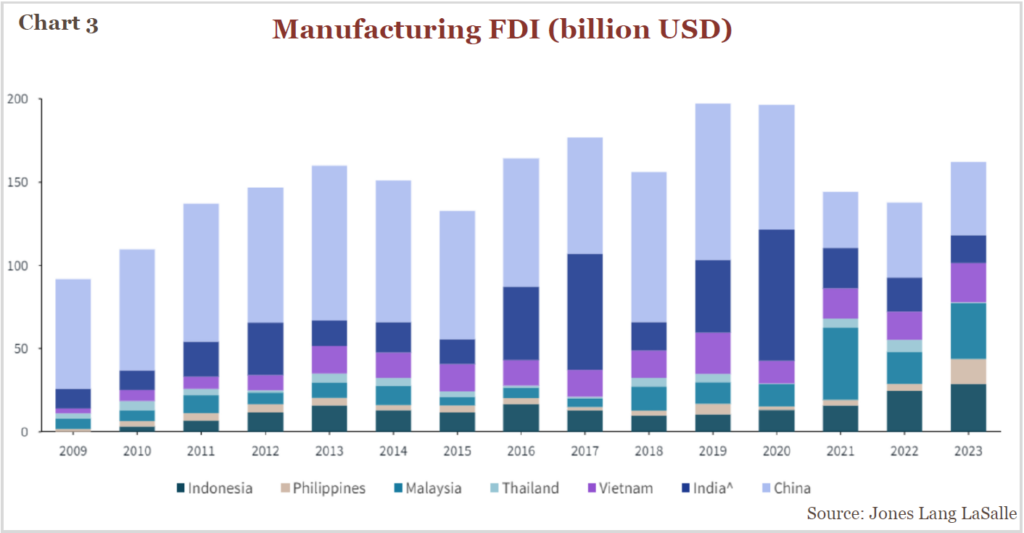,
June 18, 2024
Globalization, the interconnectedness of economies, cultures, and societies, has become a defining force of our times. While its impact is multifaceted, one undeniable benefit is its contribution to economic growth in both developed and emerging economies. Despite some trepidation, globalization has woven a tapestry of prosperity, helping raise gross domestic product (GDP) per capita in nearly every country.
The opening of world markets and the expansion of trade are not recent phenomena. While this process has evolved over centuries, it experienced a significant acceleration in the late 20th century. This surge was propelled by pivotal events such as the birth of the internet, the collapse of the Soviet Union leading to a global shift toward free-market economies, and the establishment of the World Trade Organization. In 1990, global trade accounted for 37% of global GDP; today, it exceeds 60% (see Chart 1).
As per the World Bank, global trade has not only boosted worldwide incomes by 24% since 1990 but has also lifted over 1 billion people out of poverty. Moreover, globalization has delivered substantial advantages to businesses. It has afforded companies access to new markets, unlocking vast consumer bases overseas.

Today, 41% of S&P 500 companies’ sales come from international markets, nearly double that of 1990. While access to new consumers helped accelerate sales, businesses also experienced increased efficiencies. Globalization fosters competition, driving businesses to streamline operations and reduce costs. Often, production relocates to countries with lower labor expenses, translating into more affordable goods for consumers. This dynamic not only amplifies profitability for businesses but also renders products and services more accessible to consumers. The increased efficiencies in businesses are evident in profit margins, which have also doubled for the S&P 500 index since the early 1990s.
While globalization helped facilitate technological innovation through the exchange of ideas and expertise across borders, this enhanced international cooperation also introduced risks, including domestic job losses, industrial espionage, trade secret theft, intellectual property infringement, and cybersecurity threats. To address these risks, the U.S. and other countries have implemented protectionist trade measures in recent years, including export controls, targeted government regulations, and tariffs. Examples include the U.S. adding Chinese technology firm Huawei to the “Entity List” in 2019, restricting its access to certain technologies, and more recent export controls on specific leading-edge chip technologies, like those designed by NVIDIA Corp. (NVDA).
Protectionist measures, however, vary in their justification and impact. While some, like safeguarding intellectual property, are crucial and will play a significant role in reshaping globalization, others, like the U.S. tariffs on steel, aluminum, washing machines, and apparel imported from China, are less warranted. These types of measures can lead to higher prices for consumers and can have significant negative repercussions on economic activity. The rationale behind these measures revolves around the loss of American manufacturing jobs and factory closures due to increased Chinese imports. However, the decline in manufacturing jobs predates the hyper-globalization phase of the early 90s. Since World War II, manufacturing employment in the U.S. has been steadily declining, from nearly 38% of all nonfarm workers in the early 1940s to less than 10% today (see Chart 2). Despite this decline, manufacturing production in the U.S. has not suffered a significant decrease. Instead, the sector’s stable share of real GDP (see Chart 2) combined with a decreasing share of employment indicates increased productivity attributed to innovation, automation, and increased efficiencies.

Protectionist measures on advanced technology are undoubtedly driving a new phase of globalization, but they are not the sole factor. Another crucial element in driving changes in global trade is the diversification of supply chains. Over the past decade, rising production costs and geopolitical tensions with traditional manufacturing hubs like China prompted companies to seek alternative locations. The COVID-19 pandemic further highlighted the world’s heavy dependence on a handful of countries, particularly China, for essential products. Consequently, there is now a renewed emphasis on resilience and security across various sectors, including food, water, lumber, medical supplies, prescription drugs, and energy. Companies are reevaluating their supply chain strategies, diversifying their supplier base, and leveraging technology to enhance supply chain visibility and resilience.
To achieve this, many companies are redirecting capital and expanding their supply chains to countries like India, Indonesia, Vietnam, and Malaysia. Although China remains the primary recipient of manufacturing foreign direct investment (FDI) (or when a company from one country invests directly in productive assets such as manufacturing facilities in another country), other countries are rapidly narrowing the gap. India has seen a remarkable 55% increase in manufacturing FDI over the past decade (see Chart 3). In Indonesia, manufacturing FDI surged to $28.7 billion in 2023, up $4 billion from 2022, while Vietnam experienced a growth rate surpassing 30%, reaching $23.5 billion.

U.S. auto manufacturers are also seeking to reduce risk and increase efficiencies by nearshoring operations to countries like Mexico. This strategy enhances agility in transporting final goods into the U.S., as they can utilize truck and rail transport instead of relying solely on air or ocean shipping.
Reshoring is also a strategy companies are increasingly adopting to fortify and broaden their supply chains. This approach requires ongoing investments in automation as well as government incentives, such as the CHIPS Act of 2022. While complete reshoring of entire supply chains may not be feasible, leveraging advanced technologies can effectively mitigate labor costs while concurrently reinforcing supply chain resilience.
Globalization has profoundly shaped our world, fostering economic growth and bolstering prosperity in both developed and emerging economies. Despite recent obstacles and geopolitical tensions, we foresee global trade continuing to prosper, albeit with shifts in location and beneficiaries compared to previous decades. The enduring advantages of globalization, including enhanced efficiencies, access to new markets, and technological advancements, remain unmistakable. In response to the vulnerabilities laid bare by the COVID-19 pandemic, the diversification of supply chains and strategic nearshoring have emerged as vital strategies, underscoring the imperative for resilience and security in global trade. Companies are increasingly investing in automation and advanced technologies to fortify their operations, signaling a trajectory towards a more balanced and secure approach to globalization.